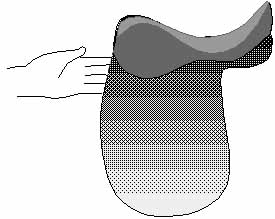
How Asymmetry affects Saddle-fit Even straight horses can experience saddle fitting problems, and asymmetry will definitely affect saddle fit. If your saddle is asymmetrical too (and this is much more common than you might think), the problem is compounded. Sometimes asymmetry in the saddle is caused over time by the horse’s own asymmetry, and sometimes it’s the other way around. No matter — both need to be straightened out. At the least, an imperfectly fitted saddle can cause the horse to contract his back muscles, preventing him from striding up, giving the rider a more uncomfortable ride, and increasing wear and tear on himself. But there can be a variety of symptoms, ranging from sore back, to grooming sensitivity, attitude and behavioural “problems”, and numerous under-saddle difficulties from stiffness to bucking, stumbling, rushing, and falling in on one shoulder when turning. Horses will often let the rider know if the saddle is uncomfortable when the girth or cinch is tightened. Their reactions range from mild to extreme: some horses will just try to move forwards as you tighten the saddle, a few will actually try to lie down, and there are a myriad other ways in between telling the handler the horse is uncomfortable. If your horse is asymmetrical in the shoulders or back, he will almost certainly have saddle-fitting problems. It’s important to check that there are no pressure points or hollow areas between the horse and saddle. If there are, adjustment requires that the hollow areas be partially filled (neoprene or other closed-cell foam “shims” work well) to lift the saddle enough to ease the pressure in the tight spots, which are usually on the other side of the back. Many people do just the opposite—padding the tight spots, which just makes them tighter.
Assuming the saddle is the cause of the horse’s asymmetry, the ideal solution is to get a saddle that fits perfectly, or with an English-style saddle it may be possible to have the present saddle restuffed to fit better. Don’t just assume, however, that all saddlemakers will fit your saddle correctly. Many feel that getting as much stuffing in the saddle as possible will cure all problems. It won't. If the rider plans to assist the horse to become more symmetrical through riding, for example, a temporary adjustment to saddle fit is usually more practical (click here to go to Saddlefitting article), and this is where the closed cell foam shims can help while the horse’s body changes. UNDER CONSTRUCITON - CHECK BACK SOON | Riding Theory Main Page | Asymmetry | Identifying Asymmetry | Asymmetry and Performance | Asymmetry and Saddlefit | Asymmetry and Riding | What to do about asymmetry | Email : rafalet2ride@yahoo.ca | Home | Lusitanos | Equine
Biomechanics & Riding Theory
| Last updated July 1, 1999 All rights reserved |
